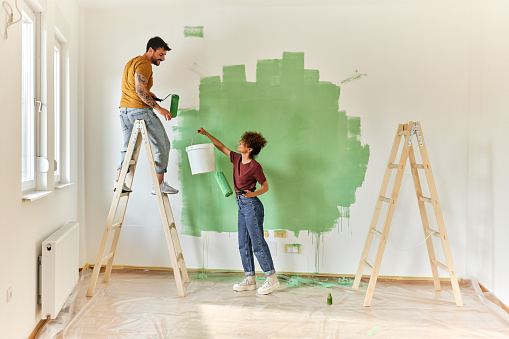DIY (Do-It-Yourself) and renovation projects are transformative endeavors that empower homeowners to personalize and improve their living spaces. From small-scale repairs to ambitious remodeling projects, DIY enthusiasts and renovators embark on journeys that blend creativity, craftsmanship, and problem-solving skills. This article explores the intricacies of DIY and renovation, discussing their benefits, challenges, and the evolving landscape of home improvement.
The Appeal of DIY and Renovation
DIY and renovation projects appeal to homeowners for several compelling reasons:
- Cost Savings: Undertaking projects independently can reduce labor costs associated with hiring professionals, making home improvement more affordable.
- Creativity and Personalization: DIY allows individuals to express their creativity and personalize their spaces according to their tastes and preferences.
- Skill Development: Engaging in DIY projects enhances practical skills such as carpentry, plumbing, electrical work, and interior design, fostering a sense of accomplishment and self-reliance.
- Control and Flexibility: Homeowners have greater control over project timelines, materials used, and design choices, ensuring that renovations align with their vision.
Types of DIY and Renovation Projects
DIY and renovation projects encompass a wide range of activities, from simple repairs and upgrades to complex structural changes and full-scale remodels:
- Basic Repairs: Patching drywall, fixing leaky faucets, replacing light fixtures, and painting walls are common DIY tasks that enhance functionality and aesthetics.
- Upgrades: Installing new flooring, upgrading kitchen cabinets, replacing countertops, and updating bathroom fixtures can significantly enhance the value and appeal of a home.
- Structural Changes: Knocking down walls to create open-plan layouts, adding extensions, or converting basements and attics into livable spaces require careful planning and often professional advice.
- Outdoor Projects: DIY landscaping, building decks, pergolas, or garden sheds are popular outdoor renovation projects that enhance curb appeal and outdoor living spaces.
Planning and Preparation
Successful DIY and renovation projects hinge on thorough planning and preparation:
- Budgeting: Setting a realistic budget that accounts for materials, tools, permits, and potential contingencies ensures financial stability throughout the project.
- Research: Gathering information on building codes, safety regulations, and best practices for specific tasks helps avoid costly mistakes and ensures compliance with local ordinances.
- Tools and Equipment: Acquiring or renting the necessary tools and equipment for the project ensures efficiency and safety during construction and renovation activities.
- Timeline: Establishing a realistic timeline based on the scope of work and available resources helps manage expectations and minimize disruption to daily routines.
Challenges of DIY and Renovation
While DIY and renovation projects offer numerous benefits, they also present challenges that require careful consideration and preparation:
- Skill Level: Undertaking complex projects without adequate skills or knowledge can lead to errors, safety hazards, and additional costs.
- Time Commitment: DIY projects often require significant time investment, especially when balancing work, family responsibilities, and other commitments.
- Unforeseen Issues: Hidden structural damage, plumbing or electrical complications, and unexpected setbacks can arise during renovations, necessitating flexibility and problem-solving skills.
- Permitting and Regulations: Obtaining necessary permits and complying with building codes and zoning regulations can be complex and time-consuming.
Safety Considerations
Safety is paramount in DIY and renovation projects. Homeowners should:
- Use Protective Gear: Wear appropriate safety gear, including goggles, gloves, and respirators, to protect against dust, debris, and hazardous materials.
- Follow Manufacturer Instructions: Adhere to manufacturer guidelines when using tools and equipment to prevent accidents and ensure proper operation.
- Turn Off Utilities: Shut off electricity, gas, and water supplies before conducting work involving electrical wiring, plumbing, or gas lines.
- Seek Professional Help: Consult with professionals for tasks that require specialized knowledge or pose significant safety risks.
Trends in DIY and Renovation
Current trends in DIY and renovation reflect broader societal shifts toward sustainability, personalization, and technological integration:
- Sustainable Materials: Increasing use of eco-friendly materials such as reclaimed wood, recycled glass countertops, and energy-efficient appliances.
- Smart Home Technology: Integration of smart thermostats, lighting systems, and security devices that enhance convenience, energy efficiency, and home automation.
- Personalization: Customization of spaces to reflect individual lifestyles and aesthetic preferences through unique design elements, colors, and textures.
- Outdoor Living: Growing interest in DIY outdoor kitchens, fire pits, pergolas, and sustainable landscaping that extend living spaces into the outdoors.
The Future of DIY and Renovation
Looking ahead, the future of DIY and renovation is shaped by advancements in technology, sustainability practices, and changing consumer preferences:
- Digital Tools: Continued development of augmented reality (AR) and virtual reality (VR) tools that assist homeowners in visualizing renovations and experimenting with design concepts.
- Prefab and Modular Solutions: Increasing availability of prefabricated and modular building components that streamline construction processes and reduce waste.
- Circular Economy: Emphasis on recycling, upcycling, and repurposing materials to minimize environmental impact and promote resource efficiency.
- Community Engagement: Growth of online platforms and communities where DIY enthusiasts and renovators share ideas, advice, and project experiences.
Conclusion
In conclusion, DIY and renovation projects empower homeowners to transform their living spaces through creativity, skill development, and personalization. Whether tackling minor repairs, upgrading interiors, or undertaking ambitious renovations, these endeavors offer a sense of achievement and ownership. While challenges such as skill requirements, time commitment, and safety considerations exist, thorough planning, research, and adherence to best practices can mitigate risks and ensure successful outcomes.
As trends evolve and technology advances, the landscape of DIY and renovation continues to expand, offering new opportunities for innovation and sustainability. By embracing these opportunities and leveraging digital tools, sustainable practices, and community support, homeowners can navigate the complexities of home improvement with confidence and create spaces that inspire and enrich their lives.
Ultimately, DIY and renovation are not just about enhancing physical structures but also about nurturing creativity, fostering skills, and building connections within communities. They represent a journey of discovery and transformation, where every project is a testament to the homeowner’s vision and commitment to creating spaces that reflect their unique identity and aspirations.










